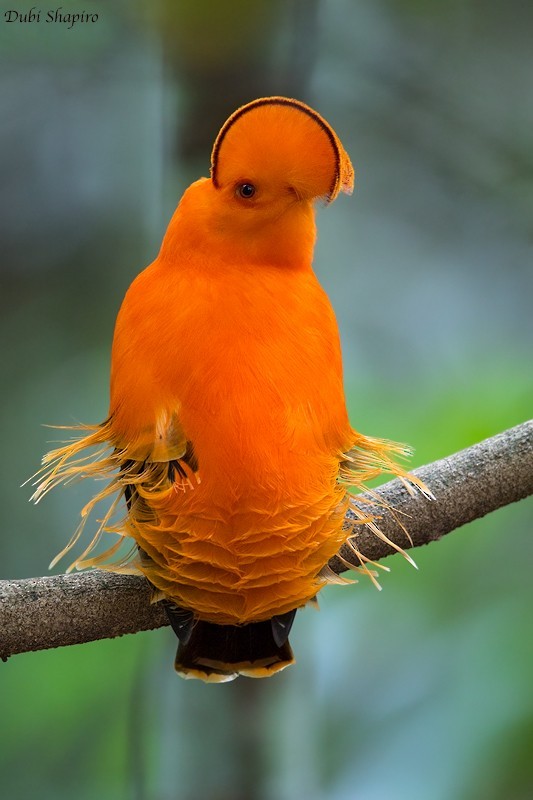Guianan Cock-of-the-rock
A species of Cocks-of-the-rock Scientific name : Rupicola rupicola Genus : Cocks-of-the-rock
Guianan Cock-of-the-rock, A species of Cocks-of-the-rock
Botanical name: Rupicola rupicola
Genus: Cocks-of-the-rock
Content
Description General Info
 Photo By Dubi Shapiro
Photo By Dubi Shapiro Description
The Guianan cock-of-the-rock is a stout-bodied bird with a prominent half-moon crest. It is a sexually dimorphic bird. The male's crest is more pronounced than the female's and is bright orange. The males also have an orange-tipped black tail, black, orange and white wings, a bright orange bill, an orange iris yellowing as it nears its outer edge, and silky-orange filamentous feathers of the inner remiges. Both sexes also have orange legs and skin. The less conspicuous female is dark brownish-grey overall and has a yellow-tipped black bill, a duller orange iris, and a smaller crest. One-year-old juvenile males look similar to an adult female, but has orange speckles over their bodies. After two years, the juvenile males become mostly orange with brown and grey spots. Males attain their definitive plumage at around three years. Juvenile females look almost identical to their adult counterparts. Guianan cocks-of-the-rock have a total length of approximately 30 centimetres (12 in) and a total weight of around 200 to 220 grams (7.1 to 7.8 oz). The two species of cock-of-the-rock are allopatric, and therefore do not meet with one another. The plumage of male Andean is redder and its wings are mostly black, lacking the orange colouration seen on the male Guianan. The female Andean is reddish brown rather than the brownish-gray of the Guianan. 
Size
32 cm
Life Expectancy
7-8 years
Nest Placement
Cliff
Feeding Habits
Guianan Cock-of-the-rock primarily feed on fruit, but their diet is opportunistic, including insects and small vertebrates. They forage in trees and shrubs, showing preferences for ripe, soft fruit. Unique adaptations allow for efficient feeding on their varied diet.
Habitat
The guianan Cock-of-the-rock thrives in damp and humid forest environments. This species is especially prevalent in territories featuring forested areas with adjacent rocky outcrops, often along the courses of rocky streams. Additionally, guianan Cock-of-the-rock can be encountered in habitats with isolated rocky outcrops within sandy-belt forests in broader geographical regions of tropical South America.
Dite type
Frugivorous
General Info
Feeding Habits
Bird food type

Fruit
Species Status
Fairly common in its large range, and with its population stable, the Guianan cock-of-the-rock is considered by the International Union for Conservation of Nature to be a Least Concern on its red list of threatened species. The main predators of the Guianan cock-of-the-rock are harpy eagles, black-and-white hawk-eagles, black hawk-eagles, bald eagles, golden eagles and slaty-backed forest falcons. Although these are the main predators, four species of owls, crested owls, Blakiston's fish owls, northern eagle-owls and spectacled owls, are also predators. Felines such as the jaguar, mountain lion, and ocelot can also be predators, along with snakes such as the bird snake, tree boas, boa constrictor, tiger rat snake, and fer-de-lance. The species is rare in captivity, but breeding has been achieved at a small number of facilities. The world's first successful captive breeding was at Dallas World Aquarium (USA) in 2008. 

 Photo By Dubi Shapiro
Photo By Dubi Shapiro Scientific Classification
Phylum
Chordates Class
Birds Order
Perching birds Family
Cotingas Genus
Cocks-of-the-rock Species
Guianan Cock-of-the-rock